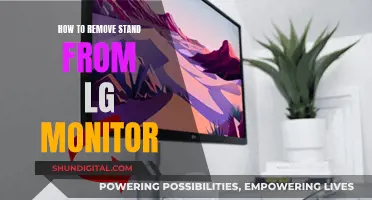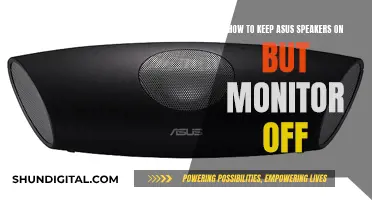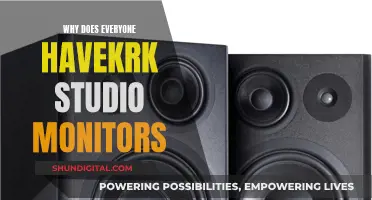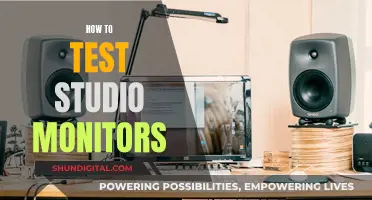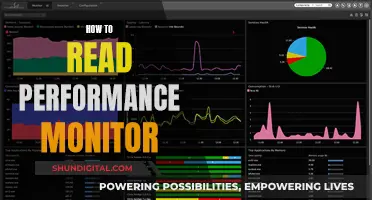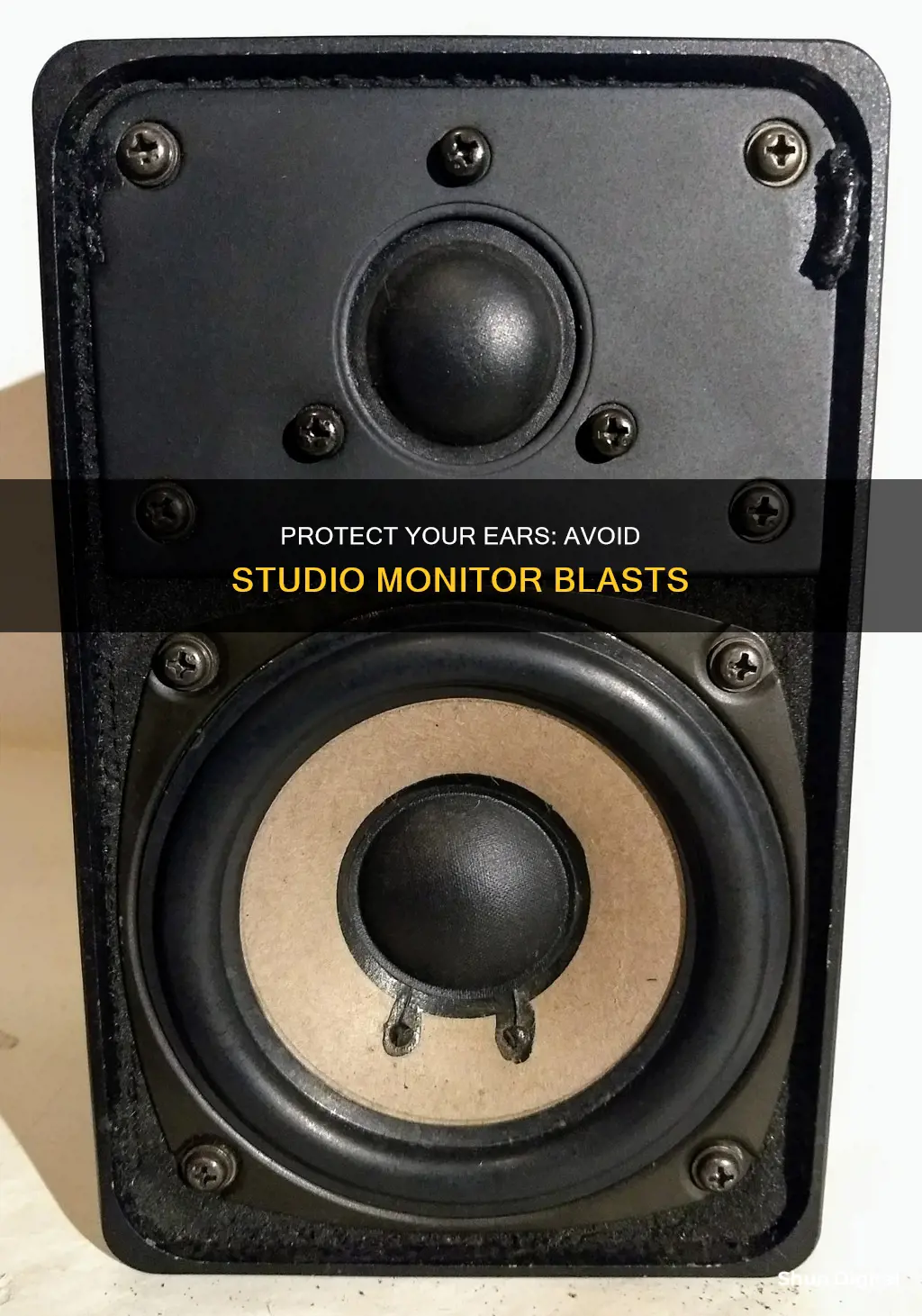
Studio monitors are specialised speakers used in recording studios to reference audio for recording, mixing, producing, and mastering. They are designed to be near-field or mid-field, meaning that the listener needs to sit close to the monitor to experience the desired effect. Studio monitors are built with delicate components that can easily be damaged by high volumes, overheating, driver malfunctions, and mistreatment. To prevent studio monitors from blowing, it is important to follow certain precautions such as using limiters to keep volumes below -0.0dB, ensuring proper ventilation to prevent overheating, and avoiding pushing on the cones with force. Additionally, it is crucial to use the correct cables and power adapters to prevent power surges and electrical issues that can damage the monitors.
What You'll Learn

Don't use near-field monitors for parties
Near-field monitors are designed for critical listening, mixing, mastering, and editing purposes. They are meant to be used in a studio setting, with the user sitting close to the monitor to get the desired effect.
Using near-field monitors for parties is not recommended as they are not designed to fill a room with sound or to be played at high volumes for extended periods. Near-field monitors have smaller drivers, commonly between 5 and 8 inches, and are typically placed no more than a few feet away from the listener. This means that they are not suitable for playing music at high volumes for a large group of people.
Additionally, near-field monitors do not have sub-bass extension, so the overall sound will be relatively flat and may not be ideal for a party setting. They are also more delicate and prone to damage if played at high volumes or misused.
If you need to play music at a party, it is recommended to rent a PA system or use other stereo equipment that is designed for playing music at high volumes for larger groups of people.
Touchscreen Monitors: Understanding Their Various Sizes
You may want to see also

Keep an eye on the levels going into the monitors
Keeping an eye on the levels going into your studio monitors is one of the best ways to avoid blowing them up. It is important to find a comfortable level for your ears and the monitors.
When using a DAW, always use limiters or soft clip audio to avoid harsh peaks and cut-off noises above a set level. This will prevent your speakers from processing sounds above that level. You should also avoid playing sounds above -0.0dB, as this can cause damage to your speakers.
Additionally, it is important to be mindful of the volume when using studio monitors for extended periods. Some monitors, especially high-end varieties, have sensitive parts that can be easily affected by high volumes over long periods. If you need to play at loud volumes, consider renting or using alternative stereo equipment.
If you start to hear distortion, noise, or rumbling, or notice any other issues, turn down the volume immediately. Your ears are a great way to tell if your speakers are being overdriven, so it is important to pay attention and adjust the levels accordingly.
Removing Sidebar on Dual Monitors: A Simple Guide
You may want to see also

Prevent power surges by using a surge protector
Power surges can be extremely detrimental to studio monitors, and they can occur due to various reasons, such as faulty wiring, lightning strikes, or even something as simple as turning on a large appliance. To safeguard your studio monitors from power surges, investing in a surge protector is essential.
A surge protector, also known as a transient voltage surge suppressor, is specifically designed to protect your devices from power surges, voltage spikes, and line noise. It acts as a safeguard, ensuring that any excess voltage is diverted away from your equipment. This is particularly important for studio monitors, as they contain delicate components that are susceptible to damage from power surges.
When choosing a surge protector, look for one with a three-pronged plug that includes a ground wire. This type of plug offers better protection against power surges compared to two-pronged adapters. Additionally, ensure that the surge protector has enough outlets to accommodate all your equipment. If you have multiple devices, consider getting a surge protector with more plugs to distribute the electricity evenly and prevent overload.
It is also crucial to connect your studio monitors and other valuable equipment to lightning-resistant plugs and adapters. While it may seem unnecessary, it can provide crucial protection during thunderstorms, preventing costly damage to your studio monitors and other electronics.
By following these steps and investing in a good-quality surge protector, you can effectively prevent power surges from damaging your studio monitors. This small investment can save you from the hassle and expense of repairing or replacing damaged equipment in the future.
Best Places to Buy an Ackie Monitor
You may want to see also

Don't push on the cones with force
Studio monitors are highly sensitive pieces of equipment, and it's important to handle them with care to avoid damage. One crucial piece of advice is to avoid pushing on the cones with force. The cones, or speaker drivers, are delicate components that can be easily damaged by excessive force or pressure. They are designed to move within a specific range, and pushing on them with force can cause them to exceed this range, leading to mechanical stress and potential damage.
The cones are responsible for converting electrical energy into mechanical energy, producing sound waves that we hear as audio. By pushing on them with force, you risk damaging the delicate materials they are made of, such as aramid, paper, or polypropylene. This can lead to tears, rips, or other physical damage that will affect the sound quality and performance of the studio monitors. Even a light touch with sharp nails can potentially cause issues if enough force is applied.
To prevent damage, always handle the studio monitors by their frame or cabinet when moving or making adjustments. Avoid touching the cones directly, as even the slightest damage can impact their performance. It's also important to be cautious when testing the drivers for tears or damage. Any unnecessary force can cause them to get damaged, so be extremely gentle when performing this check.
Additionally, be mindful of the volume levels when using your studio monitors. Playing audio at high volumes for extended periods can also lead to damage. Keep the volume at a comfortable level and use limiters to prevent sounds from exceeding a safe threshold. Remember, studio monitors are precision instruments designed for critical listening, not casual enjoyment. Treat them with care, and they will last a long time.
Monitoring Vaginal Bleeding During Pregnancy: What to Know
You may want to see also

Ensure proper ventilation to prevent overheating
Studio monitors, like all electronics, can overheat if not used under proper conditions. Overheating can cause the monitor to shut down suddenly, display distorted images, or even lead to permanent damage. To prevent this, it is crucial to ensure proper ventilation and airflow. Here are some detailed tips to ensure proper ventilation and prevent overheating in your studio setup:
- Strategic Equipment Placement: Arrange your studio equipment with adequate spacing to allow for proper airflow and heat dissipation. Place devices that generate more heat higher in the rack so that rising hot air can escape. Leave sufficient space between devices and racks to promote proper air circulation.
- Use Cooling Fans and Air Extractors: Install fans or air extractors within your setup to enhance airflow and promote cooling. These can be placed strategically within the rack or near the studio monitors to improve cooling efficiency.
- Optimise Ventilation Openings: Ensure that ventilation openings and pathways are clear of obstructions. Regularly clean and maintain the vents, fans, and filters to prevent dust and debris buildup, which can restrict airflow.
- Rack Airflow Management: Organise equipment within the rack to facilitate airflow. Allow cool air to enter and warm air to exit efficiently. Avoid blocking ventilation openings or placing equipment too close together, which can hinder airflow.
- Temperature Control: Monitor rack temperatures using temperature sensors and employ temperature control devices or intelligent cooling systems. This will help maintain optimal conditions and prevent overheating.
- Cable Management: Use cable management solutions such as cable trays and ties to keep cables organised and away from ventilation pathways. Poor cable management can impede airflow and create hotspots within the rack.
- Regular Maintenance: Regularly clean and maintain your studio monitors and equipment to prevent dust and debris buildup. Over time, dust can accumulate and restrict airflow, leading to potential overheating.
- Avoid Direct Sunlight: Place your studio monitors in a location that is not directly exposed to sunlight. Sunlight can act as an external heat source, increasing the operating temperature and potentially leading to overheating.
- Use Blanking Panels: Utilise rack blanking panels to fill empty spaces in the rack and prevent the recirculation of hot air. This helps maintain consistent temperatures and proper airflow throughout the rack.
- Optimise Room Environment: Maintain an ambient temperature in the room where your studio monitors are located. The ambient temperature can significantly impact overall cooling performance. Avoid placing the rack near heat-emitting sources or in direct sunlight.
By following these ventilation and airflow tips, you can help prevent overheating in your studio monitors, ensuring optimal performance and prolonging the lifespan of your equipment.
Easy Ways to Identify Your Monitor's Size
You may want to see also
Frequently asked questions
You may hear rattling, or a humming/buzzing sound from a tweeter. There could also be heavy distortion, pops, hissing, cracks, no sound at all, rumbling, or humming.
High volumes for long periods, overheating, driver malfunctions, and mistreating your speakers.
Always use protection, keep an eye on the level going into them, and find a comfortable level for your ears and the monitors. Always use limiters/soft clip audio when working in any DAW.
Repeated fuse blowouts are usually due to more sinister issues, such as bad transformers. Return them under warranty.
No, they are near-field monitors, good for practice due to accurate sound, but not for parties. Rent something else or use other stereo equipment.


